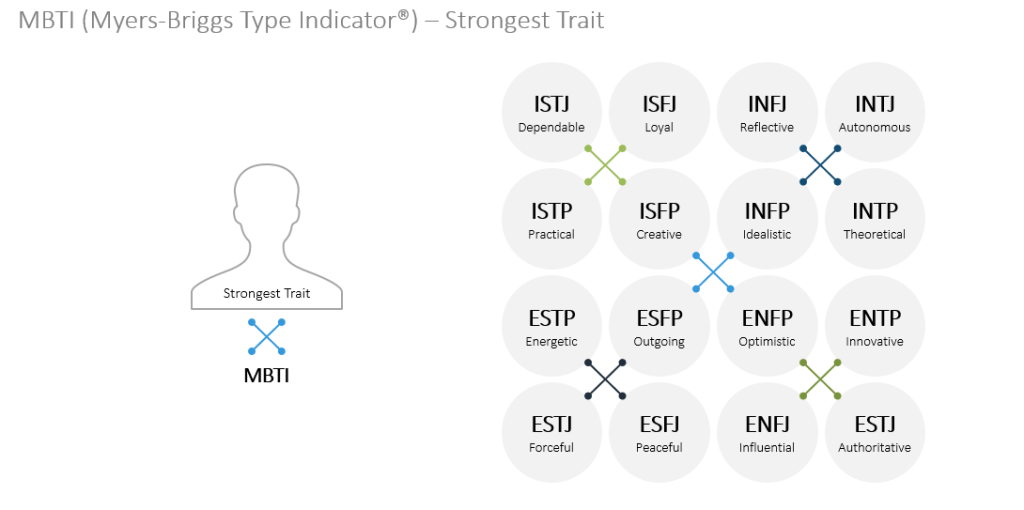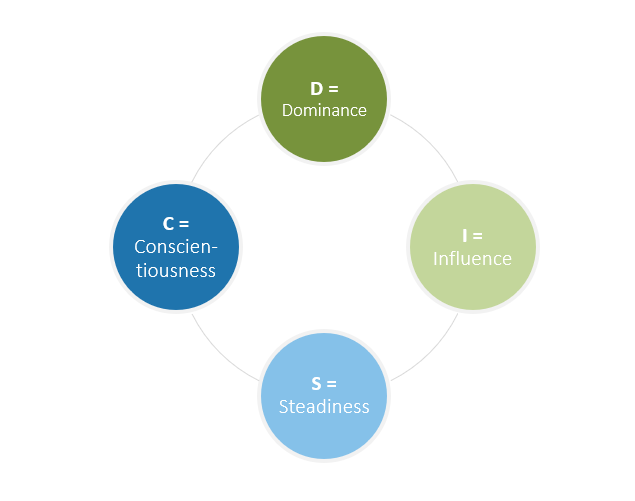
Tailor Your Presentations to Personality Types: Tips&Tricks!
Have you heard it before? Your presentation must be tailored to your target audience to be successful. That’s correct. But have you ever taken a closer look at who your target audience really is, beyond just looking at the usual data? Psychological aspects can also have a significant influence on the success of your content.
Today, we introduce you to different personality types, explain how they can help in the context of presentations, and how you can skillfully align your presentations with your audience.
Why do you need to know your target audience?
Understanding the target audience is crucial for the success of a PowerPoint presentation. An audience is composed of individual personality types, each with different needs, interests, and preferences. To make your presentation and content successful, it is essential to tailor them to these specific needs and interests.
To learn how to conduct a target audience analysis, read our article on “Target Audience Analysis.“
To create an impactful presentation, it is essential to delve into the potential audience beforehand. Only through a well-founded understanding of the different personality types can the presenter tailor their message effectively to the audience’s needs, engaging them and generating enthusiasm for the content.
Analyzing the personality types of the audience can provide insights into the most effective types of content, examples, and visual aids to capture the audience’s attention and interest.
By knowing the types, you can guarantee a more individualized approach that appreciates the audience’s diversity and uniqueness, leading to a more positive impact.
Handling the different personalities with empathy not only contributes to the audience’s attention and positive response but can also establish a deeper connection and strengthen trust in the presenter.
What are personality types?

Every individual is different, meaning that each person has their own personality traits. These traits play a central role in interactions between people and significantly influence their perception, reactions, and decisions.
Due to the diversity of personalities, various theories in personality psychology attempt to develop typologies to describe and classify the variety of individual characters. The idea behind this is to identify certain behavioral patterns, traits, and preferences that are typical for specific groups of people. Such typologies can be of great use not only in psychology but also in other areas like communication and presentation to better understand the audience’s behavior and needs.
Various Personality Models
Over time, psychology has developed different models to describe these personality traits and categorize them into typologies. Here, we introduce the most well-known models:
The Myers-Briggs Type Indicator (MBTI)

One well-known typology is the Myers-Briggs Type Indicator (MBTI), which classifies personality based on four dimensions.
The model divides people into 16 different personality types, each represented by four letters:
• Extraversion (E) or Introversion (I)
Describes where individuals feel most comfortable. Extraverted individuals are sociable and gain energy from interacting with others. Introverted individuals, on the other hand, feel more comfortable in quiet, withdrawn situations and gain energy through self-reflection.
• Sensing (S) or Intuition (N)
Describes how people perceive and process information. Sensing types prefer concrete facts and information perceived through their senses, while intuitive types are more interested in abstract ideas and connections and rely on intuition and imagination.
• Thinking (T) or Feeling (F)
Describes how decisions are made and how emotions are handled. Thinking types prefer a rational and logical approach, orienting themselves around objective criteria. Feeling types, however, place more emphasis on emotions and empathy, often making decisions by considering others’ feelings.
• Judging (J) or Perceiving (P)
Sheds light on how people interact with their external environment and organize information. Judging types prefer structure, planning, and organization and tend to make decisions and complete tasks. Perceiving types, on the other hand, are more flexible and spontaneous, keeping their options open to adapt to new information.
The model aims to help understand individual preferences and behaviors and is commonly used in personality development, teamwork, and career choices. Deeper information can be found here.
Regarding presentations, the model can provide insights into decision-making processes, information absorption, and how emotions might influence potential purchases.
The Big Five Model
The Big Five Model is a personality psychology that describes five fundamental personality dimensions:
- Neuroticism
- Extraversion
- Openness to Experience
- Agreeableness
- Conscientiousness
The model aims to capture and understand individual differences in these dimensions. It is frequently used to examine personality traits, make predictions about behavior, and has applications in various fields such as psychology, organizational development, and human resources.
Regarding presentations, the Big Five Model can be useful in several ways:
It gives insights into the personality traits of the audience, providing a better understanding of the target audience. This enables a targeted adjustment of the presentation to better accommodate various needs and preferences.
You can tailor your content based on the audience’s interests and preferences, making your presentation more relevant, engaging, and attention-grabbing. It can also be helpful in handling questions and feedback. By better understanding personality types, you can respond appropriately to questions or feedback, fostering positive interactions.
The DISC Model

The DISC model categorizes people into four main types:
• D (Dominant)
Individuals with the Dominant type are characterized by their assertiveness, determination, and goal orientation. They are often decisive, confident, and determined. People with this personality prefer clear structures and quick results and tend to like taking control.
• I (Influence)
Here, we have extroverted, enthusiastic, and social individuals. Influential persons are often charismatic, communicative, and sociable. They enjoy being in the spotlight and motivating others. Influence types are usually optimistic and tend to be attracted to new ideas and challenges.
• S (Steadiness)
The Steadiness type is calm, patient, and team-oriented. They are empathetic, loyal, and reliable. They prefer a harmonious environment and work well in cooperative teams.
• C (Conscientious)
Conscientious types are precise, detail-oriented, and analytical. Individuals of this type place great importance on accuracy, quality, and thoroughness. They are often well-organized and responsible. Conscientious personalities have high standards and work diligently and precisely.
In the context of presentations, the model can help you understand your audience’s behavior and needs and adapt your presentation accordingly. It contributes to making your PowerPoint presentations more effective, targeted, and engaging.
The Enneagram Model
The Enneagram model describes nine different personality types, each represented by a number from 1 to 9. The model shows how the nine types are interconnected and how they differ in their thinking, feeling, and behavior. Behavior patterns become clearer.
Regarding presentations, the model also helps not only to understand the audience but also to better understand one’s own personality type. This way, one can consciously utilize their strengths. Similar to the other models, valuable insights can be drawn from the personality types for your presentations, and you can skillfully adapt them.
The Four Basic Personality Types
Fundamentally, all personality models establish four similar personality types:
• The Analyst
This personality type is characterized by their love for detail and thorough approach. Analysts are rational, logical, and careful in their decisions. They prefer clear facts and data and seek precise information. In presentations, they are interested in well-structured content and well-founded arguments.
• The Pragmatist
This type is pragmatic and solution-oriented. Pragmatists prefer concrete information and practical applications to solve problems or face challenges. They are action-oriented and value clear instructions and practical examples. Visual aids and practical tips appeal to them in presentations.
• The Visionary
This type is a creative and imaginative personality type. They think in grand contexts and are interested in abstract ideas and visions of the future. They seek innovative and inspiring content. Presentations that showcase new perspectives and convey a vision capture the attention of visionaries.
• The Socially-Oriented
The socially-oriented personality type is empathetic, compassionate, and team-oriented. Socially-oriented individuals value interpersonal relationships and harmonious interactions. In presentations, they are interested in content that has social impact and promotes cohesion. Interactive elements and consideration of the social dimension in the presentation appeal to them.
Therefore, try to categorize your audience into these categories using the models. Once you have completed the categorization, you can tailor your presentation to the group accordingly.
How to Determine Your Audience Without Models

If you don’t want to delve into complex personality models but still want to recognize the types present in your audience, you can analyze your audience in the following ways:
• Observing Body Language:
Observe your audience while you present. What do their gestures, facial expressions, seating posture, and eye contact look like? These nonverbal signals also provide insights into personality types.
For example, attentive and calm listeners may potentially be Analytical types, while enthusiastic and socially interactive participants may be associated with Visionary or Influence types.
• Questionnaires/Surveys:
By using questionnaires or surveys before or after presentations, you can determine personality types. Include questions from the above-mentioned models so that participants must assess themselves, and you can define their personality types based on their responses.
Surveys after presentations can also provide information on how your presentation impacted the participants. This way, you gain insights into how different personality types received your presentation and can adapt future presentations accordingly.
• Conversations:
In personal conversations with some participants before the presentation, you can also gather information about the audience’s personality types. Informal talks or short interviews can yield insights into what the listeners expect from the presentation, which topics interest them the most, and how they typically react to presentations.
These insights can help you tailor the presentation to the interests and needs of the audience and enable a more personal approach.
How to Adapt Your Presentation to Different Personality Types
Have you identified the personality type(s)? Excellent, you’ve already taken a significant step towards improving your presentation. Now, we’ll show you some helpful tips on how to implement the insights gained for better presentations.
• Choosing the Right Language and Argumentation
A first step is to adapt your language and argumentation style. Different types prefer different approaches. This could range from clear facts and rational arguments for analytical listeners to empathetic arguments and creative ideas for socially-oriented participants.
By choosing the appropriate language and argumentation style, you can build a stronger connection with the audience and emphasize the relevance of the presentation to them.
• Adjusting Visual Aids
Slides and graphics are crucial for an effective PowerPoint presentation, regardless of the personality type. Adapt them for greater success according to the types.
For example, Analytical types may respond well to structured charts and data visualizations, while Visionary types may be intrigued by inspiring images and creative illustrations. Practical participants may feel engaged with practical examples and applications, while socially-oriented listeners may be moved by images emphasizing interpersonal relationships.
• Incorporating Interactive Elements
Interactive elements enhance audience engagement during the presentation. Based on personality types, different types of interactions can have varying impacts on your audience.
Analytical types may benefit from question-and-answer rounds or discussions, while socially-oriented listeners may respond well to group activities or partner exercises. Visionary types may profit from brainstorming sessions or creative prompts, while practical participants may be enthusiastic about practical exercises or case studies.
How to Deal with Different Personality Types in the Audience?
When you have a large group as your audience, it can be a challenge as there may be more than one personality type represented. Effectively managing mixed personality types requires sensitivity and adaptability.
What is the solution? Be flexible. You must offer a balanced mix of content and communication that caters to different preferences. Use various communication styles, incorporate different visual aids, and create engaging interactions with the audience. Only in this way can you have the chance to make each personality type in your audience feel valued and addressed.
Tip: Moderation Techniques for Diverse Audience Types
The use of moderation techniques can be particularly effective with an audience of mixed personality types. Moderation enables a structured interaction between presenters and the audience and promotes active participation from the listeners.
Through targeted questions, discussions, or group exercises, you can address various personality types and integrate their strengths into the presentation. The role of the moderator encourages the audience to contribute their opinions and thoughts, allowing for an interactive and dynamic presentation.
By employing skillful moderation techniques, you can engage different personality types and create a positive experience for the diverse audience.
Conclusion: Effectively Addressing All Personality Types

Defining personality types is not easy. However, with practice, you can assess your audience and tailor your presentations to individual preferences. Give our tips a try the next time.
Do you have any questions about the article? Feel free to contact us at [email protected]. We are here to assist you!
Are you looking for visually supportive and professionally designed slide templates? Take a look at our shop. We have numerous slides prepared for various (business) topics available for download. Check it out today! ► Go to Shop
You may also be interested in these articles:




